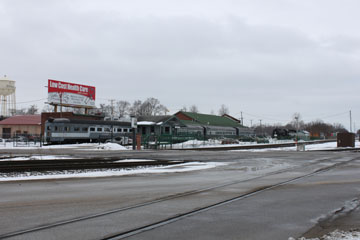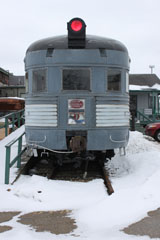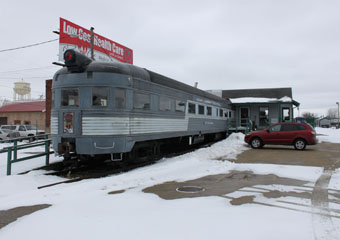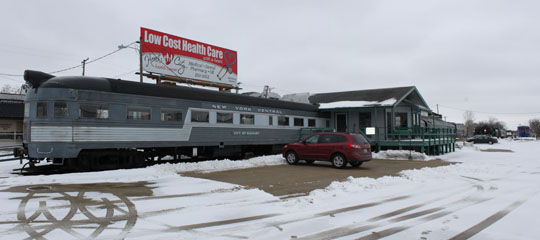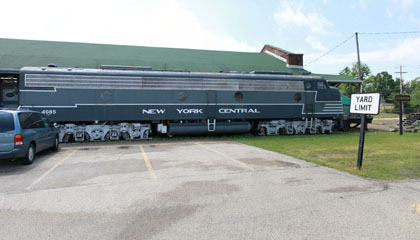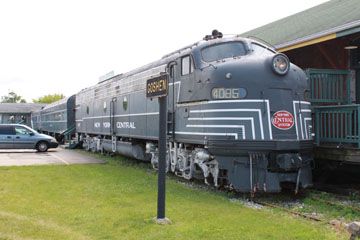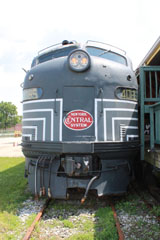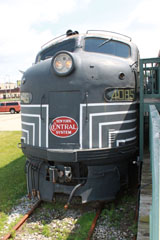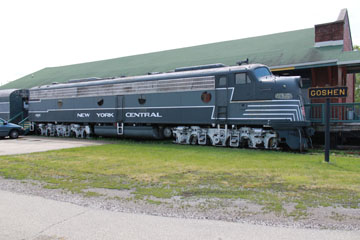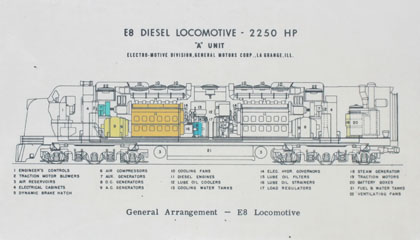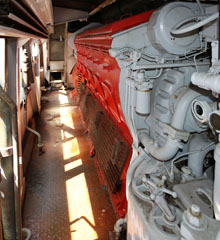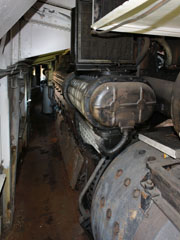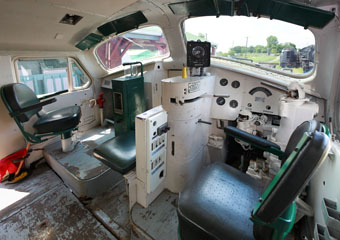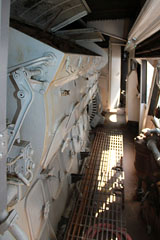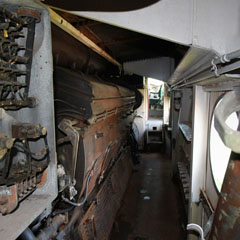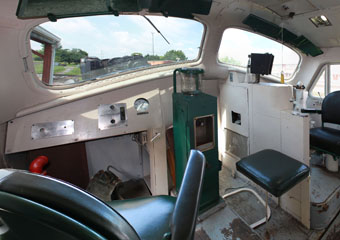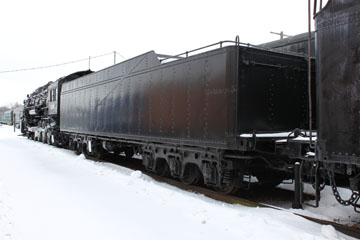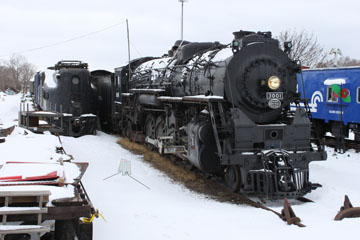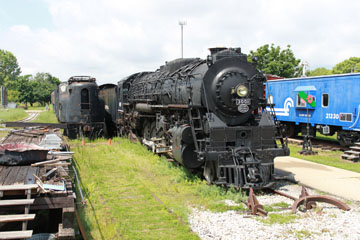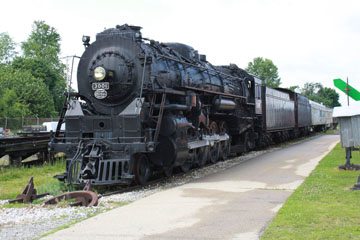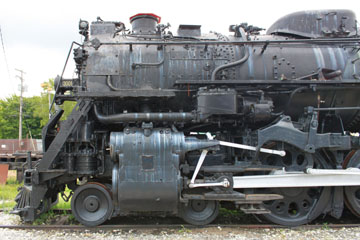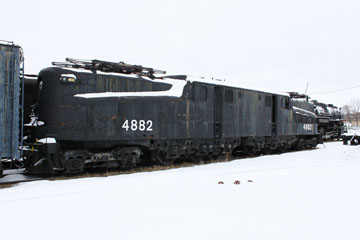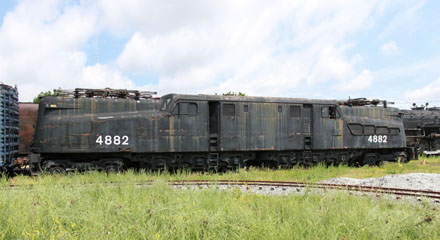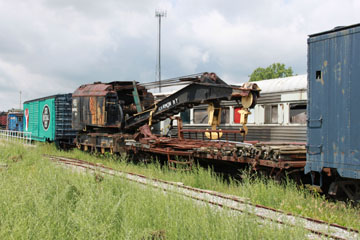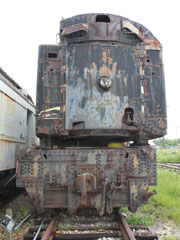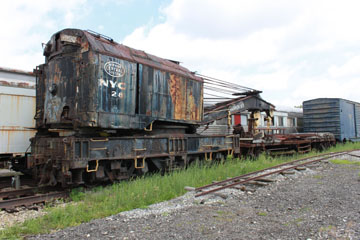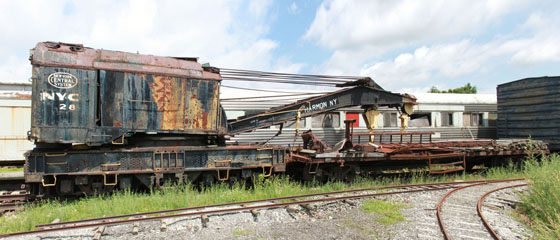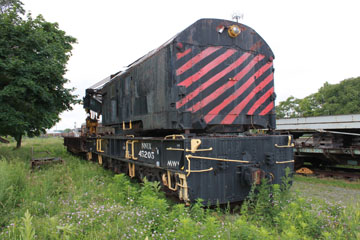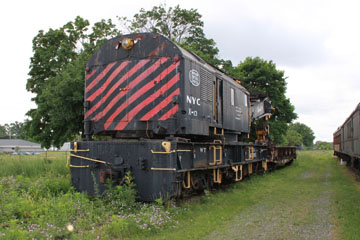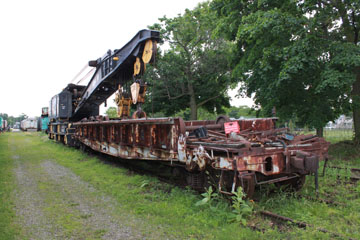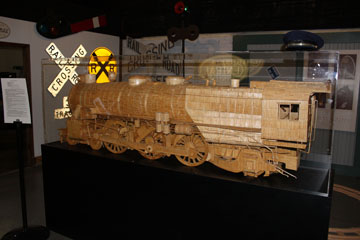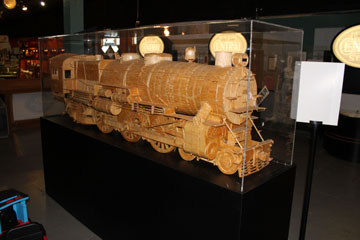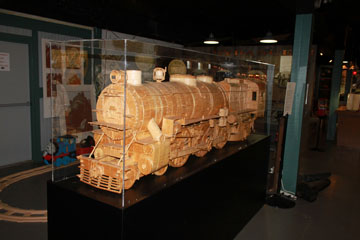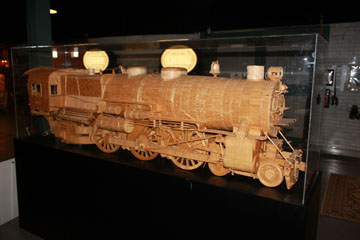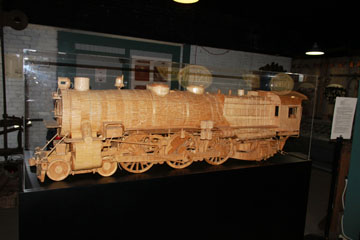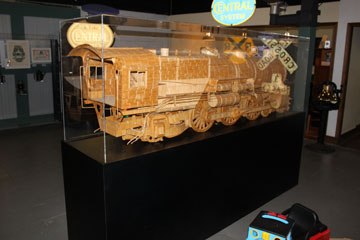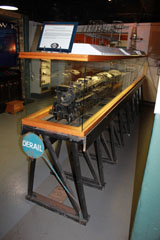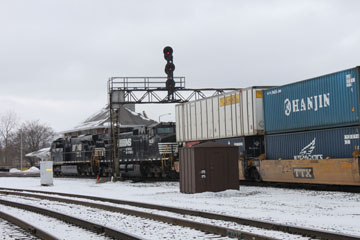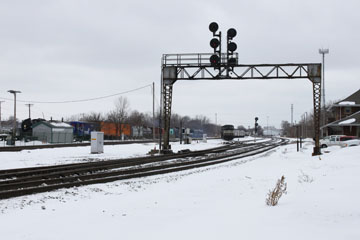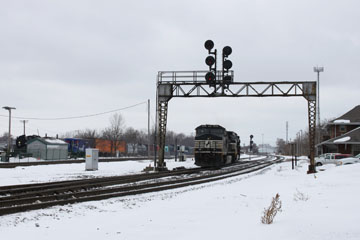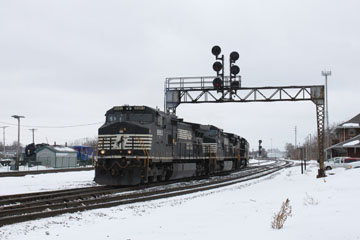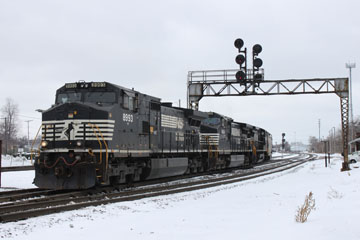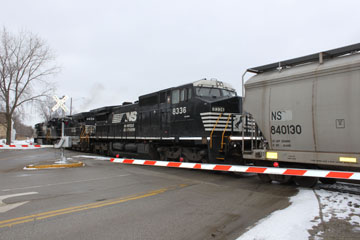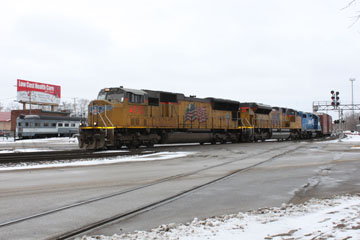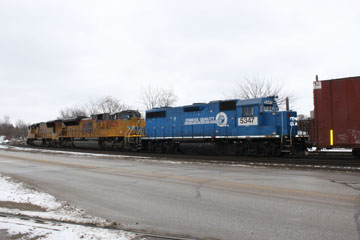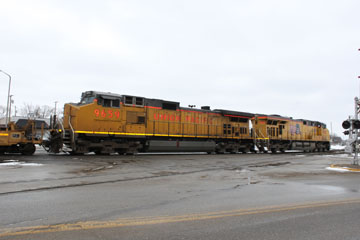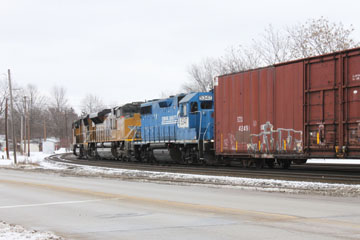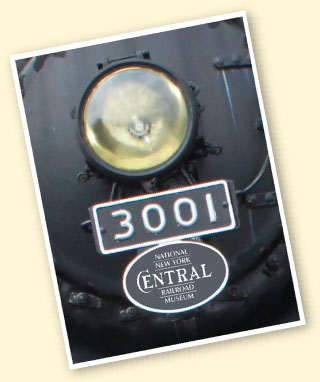

Founded in 1987, the National New York Central Museum occupies a site on S Main St opposite the Amtrak station in downtown Elkhart, IN, a town that was to become a vital link in the east-west expansion of US railroads.
The first railroad to arrive was the Lake Shore & Michigan Southern in 1833. The New York Central gained control of the LS&MS in 1914, making this a suitable location for a museum dedicated to the NYC. However, the museum is also dedicated to collecting material of more general historic railroad interest.
I have made a couple of visits and, as some of the photos show, the first was during winter. This made photographing quite challenging, so I returned one summer for some better shots.

The museum itself consists of a modified New York Central 20th Century Limited train set and a one hundred year old freight house.
Visitors enter the museum through a purpose built front lobby in the form of an Elkhart Junction depot building, although not a replica of an original. From there, they pass through a 1915 passenger car that introduces a timeline of local railroad history beginning in 1833 and tracing it through to when the NYC gained control of the LS&MS in 1914. The timeline is picked up in the freight house, which features the history of the New York Central on the local and national level. Exhibits also take visitors through the creation of Penn Central, Amtrak, Conrail and, later, Conrail's division into CSX and Norfolk Southern to complete their historic railroad journey.
The City of Elkhart is still an important railroad centre with large marshalling yards to the west of the museum, which sits beside one of the busiest railroad lines in the Midwest: during peak periods, a train rolls by on the main line roughly every fifteen minutes.
There is a small free parking area on the museum grounds, but ample space is also available across the railroad line in the Amtrak car park and beside the Post Office. As you can see from the photos at the end of this page, it is also an excellent place to get photos of the main line action!
Above, at the rear of the train, there is an authentic NYC observation car. On my first visit, a retired Pullman Porter was in attendance, offering some fascinating insights into life on the rails.
Returning to the entrance lobby, visitors can then exit through the Central System Gift Shop and follow the dock past NYC EMD E8 A #4085 at the head of the train set down to the museum's open air display of its historic motive power, maintenance of way and rolling stock collection.

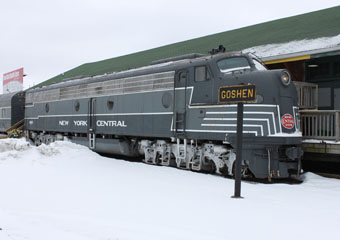
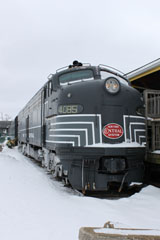
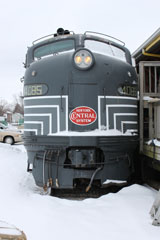
Above, NYC #4085 in the snow. This was one of thirty-two E8 A units delivered to the NYC in 1953 (#4064-#4095), the last of the sixty-two to be rostered by the railroad and amongst the last built by EMD.
Four hundred and forty six E8 A units were built for US railroads between 1949 and 1953, and three for Canadian railroads. An additional forty-six B units were produced from 1949 to 1954, all for US railroads. It was the ninth in a long line of passenger unit models known as the EMD E Series.
#4085 had the distinction of being lead unit on the 20th Century Limited when the train departed Chicago for New York City for the final time on 3rd December 1967.
The E8 A weighs 315,000 lbs (290,000 lbs for a B unit). 70' 3" long,
it has two 3 axle trucks with 36" wheels and a
14' 1" wheel base. With a top speed of 85 mph it delivered 56,500 lbs starting tractive effort at 25% and 31,000 lbs continuous tractive effort at 11 mph.
The profile of the E8 cab unit nose when
viewed from the side has been compared to a bulldog's snout. Earlier E-unit locomotives had a more slanted nose and were nicknamed "shovel nose" or "slant nose" units, but the E7, E8 and E9 units (as well as the four axle F unit series) were consequently nicknamed "bulldog nose" units.
Two 1,125 hp, 12 cylinder, model 567B prime movers in the engine compartment each drove its own GM D27 generator to power the four GM D37 traction motors.
Left, an information panel beside #4085 shows the locomotive's internal workings and visitors can climb inside the engine compartment as well as, below, going into the cab to view the original controls.
Fifty-eight E8 units have survived and a
number are still operating on short line and heritage railroads. You can see SOU #6900 on the North Carolina Transportation Museum page of this website, and PRR E8 #5794 liveried as FEC #1594 on the Gold Coast Railroad Museum page.

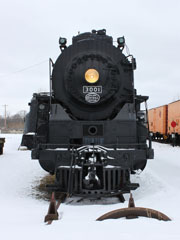

Above, right and below, New York Central L-3a class Mountain (4-8-2) type locomotive #3001.
Known as "Mohawks" on the NYC, the railroad eventually rostered six hundred of this type, by far the largest number of any US railroad (the next largest was PRR'S three hundred and one).
Four classes of Mohawk were built for the NYC by Alco and Lima between 1916 and 1943: L-1, L-2,
L-3 and L-4.
They were the NYC's pre-eminent freight power which, because of its almost gradeless water-level routes, never needed the larger freight power of other railroads.
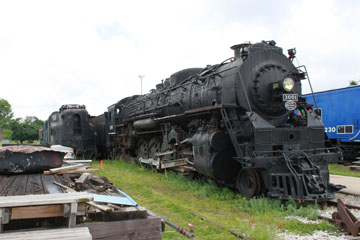
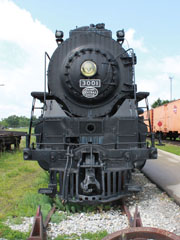
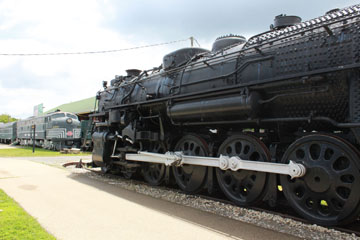
The L-3a was the first Mohawk built as a dual service locomotive for both freight and passenger service.
The design was based on modifications to two L-2 locomotives: higher boiler pressure, light-weight reciprocating parts and roller bearings on all axles.
In 1957, #3001 was sold to the City of Dallas to replace Texas & Pacific #638 at the Texas State Fairgrounds. In 1984, it was traded to the National New York Central Railroad Museum in exchange for former PRR GG1 #4903.
#3001 has 69" drivers and 25½" x 30" cylinders. With a 75.3 sq ft grate, 373 sq ft firebox and total heating surface of 6,758 sq ft (incl. 2,082 superheating), it operated at a boiler pressure of 250 psi delivering 60,077 lbs tractive effort. Since these photos were taken, the locomotive has been cosmetically restored.
The success of the modified L-2s prompted construction of twenty-five L-3a locomotives by Alco in 1940 for dual service (#300-#3024) and forty for freight only (#3025-#3064).
#3001 hauled both freight and passenger trains, including the 20th Century Limited.

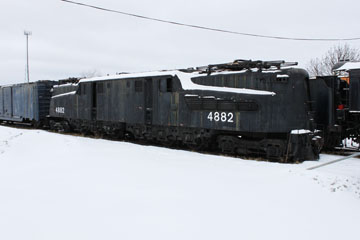
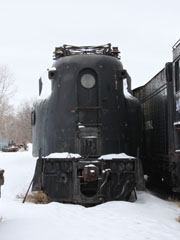
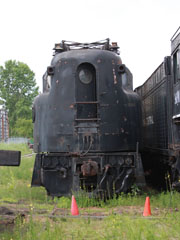

One hundred and forty of the GG1 class of electric locomotive were built between 1934 and 1943, mainly at Pennsy's Juniata workshops.
Initially introduced into service in 1935, many operated under Pennsy's successors, Penn Central, Conrail and Amtrak, into the early 1980s.
Sixteen GG1s have been preserved.
The prototype GG1, PRR #4800 "Old Rivets", is on the Railroad Museum of Pennsylvania Yard page of this website. PRR #4903 is on the Museum of the American Railroad page, PRR #4919 is on the Virginia Museum of Transportation page and PRR #4935 is on the Railroad Museum of Pennsylvania Train Shed page.
The GG1 was designed to haul 12-14 passenger car consists on the PRR's electrified sections between New York, NY, Washington, DC, and Harrisburg, PA.
#4882 served on the Pennsy, Penn Central, Conrail, Amtrak and, finally, New Jersey Transit. Retired in 1983 it was one of the last three GG1s to be used in revenue service (#4877, #4879 and #4882), but had the honour of being the last GG1 to run under its own power when it pulled #4877 and #4879 into the Matawan, NJ, yard after a "Farewell to the GG1s Day." It arrived in Elkhart in 1989 and was repainted in Penn Central livery in 1998.


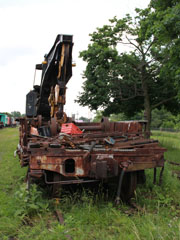
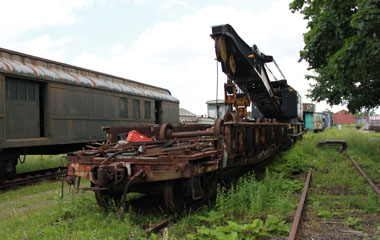
#X-13 is the first of four oil fired, self propelled steam cranes built for the NYC by Industrial Brownhoist between 1948 and 1949 (#X-13-#X-16). #X-13 was based at Selkirk, NY, the others at Collinwood, OH, Elkhart, IN, and Indianapolis, IN.
You can see more Industrial Brownhoist cranes on the B&O Railroad Museum Yard & Car Shop page of this website and the Nevada Northern Railroad Museum page, the Ogden Union Station page, Gold Coast Railroad Museum page, Pennsylvania Railroad Museum Yard page and Virginia Museum of Transportation page.

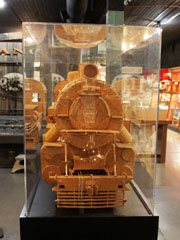
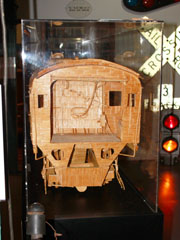

This 8' long, one-sixth scale model of a PRR K4 (#417) built by Terry Woodling of Warsaw, IN, contains 40 lbs of glue and 421,250 toothpicks! Completed in 1991, it took seven years to build and its wheels, side rods, brakes and windows all move.
The PRR built four hundred and twenty-five K4 Pacific (4-6-2) type locomotives between 1914 and 1928. They were one of the most successful passenger steam locomotives ever built and outnumbered any others of their type in the US. You can see PRR K4 #3750 on the Pennsylvania Railroad Museum Yard page of this website.

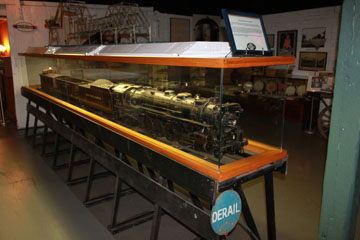
This one-twelfth scale model of a NYC L-2a class "Mohawk" (4-8-2) type was built by Richard Stolzefels from original blueprints. It is one of the museum's first acquisitions.
Visitors are invited to compare it to full size NYC L-3a #3001 on display outside.
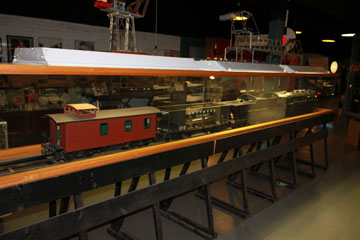

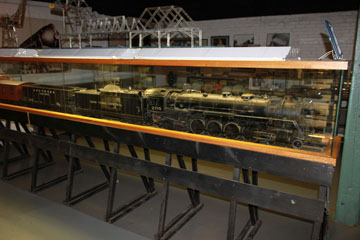
The second of the "Mohawk" class built for the NYC, the L-2a was fitted with an Elesco type feedwater heater mounted in front of the smokebox, giving it a characteristically beetle browed look (later L-2b and L-2c locomotives had recessed feedwater heaters).
Three hundred of the L-2 class were built from 1925 to 1929, all by Alco. Weighing 362,500 lbs, #2715 was one of the first batch of L-2as outshopped in 1925. With 27" x 30" cylinders and 69" drivers, it operated at a boiler pressure of 225 psi, delivering 60,618 lbs tractive effort.

Below and right, NS GE C40-9W #8933, NS GE C40-9W #9434 and NS GE C40-8W #8336 taking a mixed freight west through Elkhart and crossing S Main St.
GE built seven hundred and fifty-six C40-8W units (also known as Dash 8-40CW) between 1990 and 1994. The "W" stands for "wide" or "safety" cab. The C44-9W (also known as Dash 9-44CW) superseded the C40-8W in 1994. GE also built one thousand and ninety C40-9W units (also known as Dash 9-40CW) exclusively for Norfolk Southern from 1996 to 2005.
As it is located right beside one of the busiest sections of main line in the mid west, the museum is a great place to catch track side action.
Above, NS GE ES40DC #7542 hauls a double
stack freight east with NS GE C40-90W #9630. #7542 is apparently Norfolk Southern's only ES40DC with the large horsehead logo on its side. The ES40DC is part of GE's Evolution Series,
4,000 hp with DC traction. It replaced the Dash 9-40CW model in GE's range and, like that former model, has been delivered exclusively to Norfolk Southern.
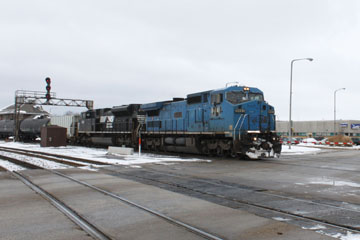
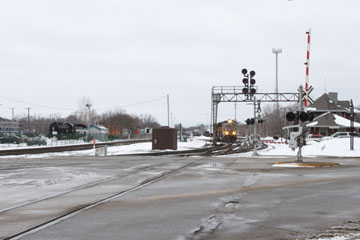
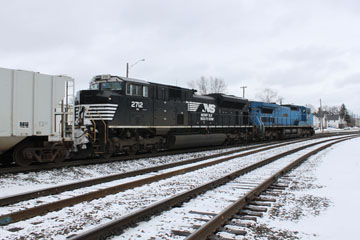
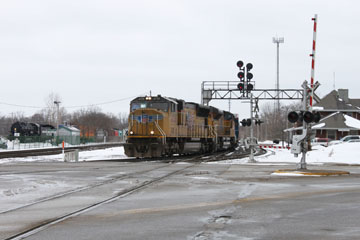
Above, NS GE C40-8W #8461 and NS EMD
SD70M-2 #2712 haul a mixed freight west.
#2712 is one of GE's SD70 series, over four thousand of which have been built since 1992. Both the original SD70 and the later SD70M have a 16 cylinder 710G3B prime mover powering a GM AR20 generator to drive six GM D-100 DC traction motors. They produce 113,100 lbs continuous tractive effort at 13 mph with a top speed of 70 mph. Production of the SD70M was replaced by the SD70M-2 in late 2004, as the EPA's Tier II regulations went into effect on 1st January 2005.
Left and below, UP EMD SD70M #4735, UP GE SD70ACe #8625 and CR EMD GP38-2 #5347 with another west bound mixed freight.
The 4,300 hp SD70ACe meets the 2005 EPA regulations for road locomotives, but several other changes have been made compared to earlier SD70 units. The radiator is nearly as wide as the cab, and the nose has been modified to produce a more angular effect. The GP38-2 is an upgraded version of EMD's earlier GP38. Two thousand, two hundred and fifteen of these units were produced from 1972 to 1986.
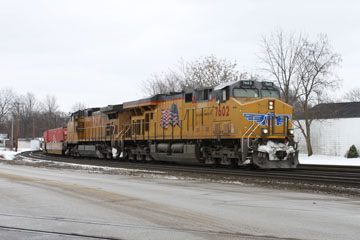
Above, UP GE ES44AC #7602 and UP GE
C44-9W #9659 heading east.
The ES44AC is another of GE's Evolution Series. It has a 4-cycle Model GEVO 12 prime mover, which powers a GE GMG196A generator to drive six GE B13B2B AC traction motors. With a top speed of 70 mph, it produces 166,000 lbs continuous tractive effort at 13.7 mph. The UP refers to these units as C45ACCTE. The CTE stands for "controlled tractive effort", a feature that reduces the tractive effort the units put out without sacrificing dynamic braking while operating in multiple units.


